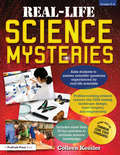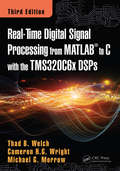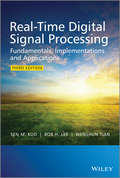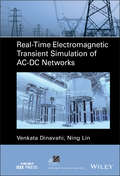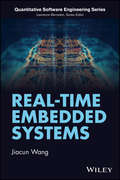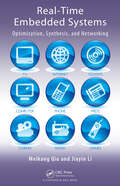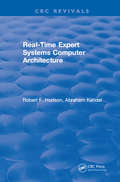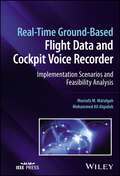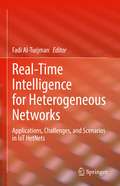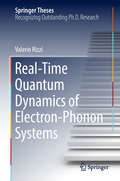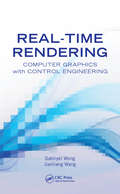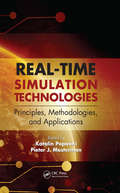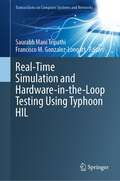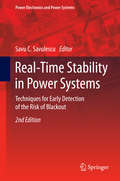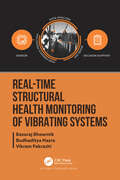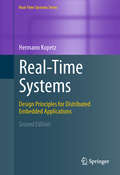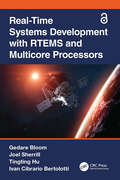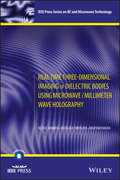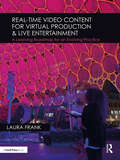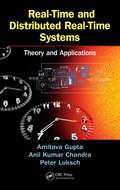- Table View
- List View
Real-Life Science Mysteries: Grades 5-8
by Colleen KesslerReal-Life Science Mysteries puts an exciting new spin on scientific thinking by profiling real-life scientists, showing students in grades 5-8 ways they can use science in their everyday lives. From a biologist studying the habits of garter snakes in Manitoba, Canada, to a landscape designer and greenhouse owner in Ohio, the scientists in this book share information and solutions to the thorniest problems they face in their scientific careers.With the more than 30 activities included in Real-Life Science Mysteries, students will be required to try their hand at solving common science problems and performing experiments while learning about real people from diverse backgrounds, all of whom share a love for discovering how they work, why things work, and how they can work better. This book is perfect for any science classroom or young scientists looking to increase their knowledge!Grades 5-8
Real-Time BCI System Design to Control Arduino Based Speed Controllable Robot Using EEG (SpringerBriefs in Applied Sciences and Technology)
by Swagata Das Devashree Tripathy Jagdish Lal RahejaThis book discusses the basic requirements and constraints in building a brain–computer interaction system. These include the technical requirements for building the signal processing module and the acquisition module. The major aspects to be considered when designing a signal acquisition module for a brain–computer interaction system are the human brain, types and applications of brain–computer systems, and the basics of EEG (electroencephalogram) recording. The book also compares the algorithms that have been and that can be used to design the signal processing module of brain–computer interfaces, and describes the various EEG-acquisition devices available and compares their features and inadequacies. Further, it examines in detail the use of Emotiv EPOC (an EEG acquisition module developed by Emotiv) to build a complete brain–computer interaction system for driving robots using a neural network classification module.
Real-Time Digital Signal Processing from MATLAB to C with the TMS320C6x DSPs (Third Edition)
by Cameron H.G. Wright Michael G. Morrow Thad B. WelchThis updated edition gives readers hands-on experience in real-time DSP using a practical, step-by-step framework that also incorporates demonstrations, exercises, and problems, coupled with brief overviews of applicable theory and MATLAB applications. Organized in three sections that cover enduring fundamentals and present practical projects and invaluable appendices, this new edition provides support for the most recent and powerful of the inexpensive DSP development boards currently available from Texas Instruments: the OMAP-L138 LCDK. It includes two new real-time DSP projects, as well as three new appendices: an introduction to the Code Generation tools available with MATLAB, a guide on how to turn the LCDK into a portable battery-operated device, and a comparison of the three DSP boards directly supported by this edition.
Real-Time Digital Signal Processing: Fundamentals, Implementations and Applications
by Bob H. Lee Sen M. Kuo Wenshun TianCombines both the DSP principles and real-time implementations and applications, and now updated with the new eZdsp USB Stick, which is very low cost, portable and widely employed at many DSP labs. Real-Time Digital Signal Processing introduces fundamental digital signal processing (DSP) principles and will be updated to include the latest DSP applications, introduce new software development tools and adjust the software design process to reflect the latest advances in the field. In the 3rd edition of the book, the key aspect of hands-on experiments will be enhanced to make the DSP principles more interesting and directly interact with the real-world applications. All of the programs will be carefully updated using the most recent version of software development tools and the new TMS320VC5505 eZdsp USB Stick for real-time experiments. Due to its lower cost and portability, the new software and hardware tools are now widely used in university labs and in commercial industrial companies to replace the older and more expensive generation. The new edition will have a renewed focus on real-time applications and will offer step-by-step hands-on experiments for a complete design cycle starting from floating-point C language program to fixed-point C implementation, code optimization using INTRINSICS, and mixed C-and-assembly programming on fixed-point DSP processors. This new methodology enables readers to concentrate on learning DSP fundamentals and innovative applications by relaxing the intensive programming efforts, namely, the traditional DSP assembly coding efforts. The book is organized into two parts; Part One introduces the digital signal processing principles and theories, and Part Two focuses on practical applications. The topics for the applications are the extensions of the theories in Part One with an emphasis placed on the hands-on experiments, systematic design and implementation approaches. The applications provided in the book are carefully chosen to reflect current advances of DSP that are of most relevance for the intended readership. Combines both the DSP principles and real-time implementations and applications using the new eZdsp USB Stick, which is very low cost, portable and widely employed at many DSP labs is now used in the new edition Places renewed emphasis on C-code experiments and reduces the exercises using assembly coding; effective use of C programming, fixed-point C code and INTRINSICS will become the main focus of the new edition. Updates to application areas to reflect latest advances such as speech coding techniques used for next generation networks (NGN), audio coding with surrounding sound, wideband speech codec (ITU G.722.2 Standard), fingerprint for image processing, and biomedical signal processing examples. Contains new addition of several projects that can be used as semester projects; as well as new many new real-time experiments using TI’s binary libraries – the experiments are prepared with flexible interface and modular for readers to adapt and modify to create other useful applications from the provided basic programs. Consists of more MATLAB experiments, such as filter design, algorithm evaluation, proto-typing for C-code architecture, and simulations to aid readers to learn DSP fundamentals. Includes supplementary material of program and data files for examples, applications, and experiments hosted on a companion website. A valuable resource for Postgraduate students enrolled on DSP courses focused on DSP implementation & applications as well as Senior undergraduates studying DSP; engineers and programmers who need to learn and use DSP principles and development tools for their projects.
Real-Time Electromagnetic Transient Simulation of AC-DC Networks (IEEE Press Series on Power and Energy Systems)
by Ning Lin Venkata DinavahiExplore a comprehensive and state-of-the-art presentation of real-time electromagnetic transient simulation technology by leaders in the field Real-Time Electromagnetic Transient Simulation of AC-DC Networks delivers a detailed exposition of field programmable gate array (FPGA) hardware based real-time electromagnetic transient (EMT) emulation for all fundamental equipment used in AC-DC power grids. The book focuses specifically on detailed device-level models for their hardware realization in a massively parallel and deeply pipelined manner as well as decomposition techniques for emulating large systems. Each chapter contains fundamental concepts, apparatus models, solution algorithms, and hardware emulation to assist the reader in understanding the material contained within. Case studies are peppered throughout the book, ranging from small didactic test circuits to realistically sized large-scale AC-DC grids. The book also provides introductions to FPGA and hardware-in-the-loop (HIL) emulation procedures, and large-scale networks constructed by the foundational components described in earlier chapters. With a strong focus on high-voltage direct-current power transmission grid applications, Real-Time Electromagnetic Transient Simulation of AC-DC Networks covers both system-level and device-level mathematical models. Readers will also enjoy the inclusion of: A thorough introduction to field programmable gate array technology, including the evolution of FPGAs, technology trends, hardware architectures, and programming tools An exploration of classical power system components, e.g., linear and nonlinear passive power system components, transmission lines, power transformers, rotating machines, and protective relays A comprehensive discussion of power semiconductor switches and converters, i.e., AC-DC and DC-DC converters, and specific power electronic apparatus such as DC circuit breakers An examination of decomposition techniques used at the equipment-level as well as the large-scale system-level for real-time EMT emulation of AC-DC networks Chapters that are supported by simulation results from well-defined test cases and the corresponding system parameters are provided in the Appendix Perfect for graduate students and professional engineers studying or working in electrical power engineering, Real-Time Electromagnetic Transient Simulation of AC-DC Networks will also earn a place in the libraries of simulation specialists, senior modeling and simulation engineers, planning and design engineers, and system studies engineers.
Real-Time Embedded Systems
by Jiacun WangOffering comprehensive coverage of the convergence of real-time embedded systems scheduling, resource access control, software design and development, and high-level system modeling, analysis and verification Following an introductory overview, Dr. Wang delves into the specifics of hardware components, including processors, memory, I/O devices and architectures, communication structures, peripherals, and characteristics of real-time operating systems. Later chapters are dedicated to real-time task scheduling algorithms and resource access control policies, as well as priority-inversion control and deadlock avoidance. Concurrent system programming and POSIX programming for real-time systems are covered, as are finite state machines and Time Petri nets. Of special interest to software engineers will be the chapter devoted to model checking, in which the author discusses temporal logic and the NuSMV model checking tool, as well as a chapter treating real-time software design with UML. The final portion of the book explores practical issues of software reliability, aging, rejuvenation, security, safety, and power management. In addition, the book: Explains real-time embedded software modeling and design with finite state machines, Petri nets, and UML, and real-time constraints verification with the model checking tool, NuSMV Features real-world examples in finite state machines, model checking, real-time system design with UML, and more Covers embedded computer programing, designing for reliability, and designing for safety Explains how to make engineering trade-offs of power use and performance Investigates practical issues concerning software reliability, aging, rejuvenation, security, and power management Real-Time Embedded Systems is a valuable resource for those responsible for real-time and embedded software design, development, and management. It is also an excellent textbook for graduate courses in computer engineering, computer science, information technology, and software engineering on embedded and real-time software systems, and for undergraduate computer and software engineering courses.
Real-Time Embedded Systems: Open-Source Operating Systems Perspective (Embedded Systems)
by Ivan Cibrario Bertolotti Gabriele ManduchiFrom the Foreword: "…the presentation of real-time scheduling is probably the best in terms of clarity I have ever read in the professional literature. Easy to understand, which is important for busy professionals keen to acquire (or refresh) new knowledge without being bogged down in a convoluted narrative and an excessive detail overload. The authors managed to largely avoid theoretical-only presentation of the subject, which frequently affects books on operating systems. … an indispensable [resource] to gain a thorough understanding of the real-time systems from the operating systems perspective, and to stay up to date with the recent trends and actual developments of the open-source real-time operating systems." —Richard Zurawski, ISA Group, San Francisco, California, USA Real-time embedded systems are integral to the global technological and social space, but references still rarely offer professionals the sufficient mix of theory and practical examples required to meet intensive economic, safety, and other demands on system development. Similarly, instructors have lacked a resource to help students fully understand the field. The information was out there, though often at the abstract level, fragmented and scattered throughout literature from different engineering disciplines and computing sciences. Accounting for readers’ varying practical needs and experience levels, Real Time Embedded Systems: Open-Source Operating Systems Perspective offers a holistic overview from the operating-systems perspective. It provides a long-awaited reference on real-time operating systems and their almost boundless application potential in the embedded system domain. Balancing the already abundant coverage of operating systems with the largely ignored real-time aspects, or "physicality," the authors analyze several realistic case studies to introduce vital theoretical material. They also discuss popular open-source operating systems—Linux and FreRTOS, in particular—to help embedded-system designers identify the benefits and weaknesses in deciding whether or not to adopt more traditional, less powerful, techniques for a project.
Real-Time Embedded Systems: Optimization, Synthesis, and Networking
by Meikang Qiu Jiayin LiUbiquitous in today's consumer-driven society, embedded systems use microprocessors that are hidden in our everyday products and designed to perform specific tasks. Effective use of these embedded systems requires engineers to be proficient in all phases of this effort, from planning, design, and analysis to manufacturing and marketing.Taking a sys
Real-Time Environmental Monitoring: Sensors and Systems - Lab Manual
by Miguel F. AcevedoThis lab manual is a companion to the second edition of the textbook Real-Time Environmental Monitoring: Sensors and Systems. Tested in pedagogical settings by the author for many years, it includes applications with state-of-the-art sensor technology and programs such as R, Python, Arduino, PHP, HTML, and SQL. It helps students and instructors in science and engineering better understand how to use and design a variety of sensors, and how to build systems and databases when monitoring different environments such as soil, water, and air. Examples of low-cost and open-access systems are included and can serve as the basis of learning tools for the concepts and techniques described in the textbook. Furthermore, the manual provides links to websites and scripts in R that allow learning how to analyze a variety of datasets available from repositories and databases maintained by many agencies and institutions. The first hands-on environmental monitoring lab manual written in tutorial style and classroom tested. Includes 14 lab guides that parallel the theory developed in 14 chapters in the companion textbook. Provides clear step-by-step protocols to understand basic and advanced theory through applicable exercises and problems. Injects a practical implementation of the existing textbook. A valuable guide for students and practitioners worldwide engaged in efforts to develop, employ, and maintain environmental monitors. Intended for upper-level undergraduate and graduate students taking courses in electrical engineering, civil and environmental engineering, mechanical engineering, geosciences, and environmental sciences, as well as instructors who teach these courses. Professionals working in fields such as environmental services, and researchers and academics in engineering will also benefit from the range of topics included in this lab manual.
Real-Time Environmental Monitoring: Sensors and Systems - Textbook
by Miguel F. AcevedoWritten 10 years after the publication of the first edition, this updated edition of Real-Time Environmental Monitoring: Sensors and Systems introduces the fundamentals of environmental monitoring based on electronic sensors, instruments, systems, and software that allow continuous and long-term ecological and environmental data collection. It accomplishes two objectives: explains how to use sensors for building more complex instruments, systems, and databases, and introduces a variety of sensors and systems employed to measure environmental variables in air, water, soils, vegetation canopies, and wildlife observation and tracking. This second edition is thoroughly updated in every aspect of technology and data, and each theoretical chapter is taught parallel with a hands-on application lab manual. Emphasizes real-time monitoring as an emerging area for environmental assessment and compliance and covers the fundamentals on how to develop sensors and systems Presents several entirely new topics not featured in the first edition, including remote sensing and GIS, machine learning, weather radar and satellites, groundwater monitoring, spatial analysis, and habitat monitoring Includes applications to many environmental and ecological systems Uses a practical, hands-on approach with the addition of an accompanying lab manual, which students can use to deepen their understanding, based on the author’s 40 years of academic experience Intended for upper-level undergraduate and graduate students, taking courses in civil and environmental engineering, electrical engineering, mechanical engineering, geosciences, and environmental sciences, as well as professionals working in environmental services, and researchers and academics in engineering.
Real-Time Expert Systems Computer Architecture
by R.F. HodsonExpert systems and real-time systems technology have been developed independently. Expert systems have been successfully implemented in many complex applications traditionally performed by human experts. Real-time systems have been successfully applied in areas requiring interaction with dynamic environments, control and monitoring applications for example. Merging these two technologies will yield intelligent systems capable of interacting with complex dynamic environments, an area in which human operators exhibit poor productivity, due to cognitive overload.
Real-Time Ground-Based Flight Data and Cockpit Voice Recorder: Implementation Scenarios and Feasibility Analysis
by Mustafa M. Matalgah Mohammed Ali AlqodahReal-Time Ground-Based Flight Data and Cockpit Voice Recorder Unique text determining the feasibility for implementation and manufacture of ground-based black box systems Real-Time Ground-Based Flight Data and Cockpit Voice Recorder helps familiarize the reader with the nature of issues surrounding existing black box technology integrated on aircrafts and to understand the benefits and importance of proposed real-time ground-based alternative solutions. These are based on predicting aircraft problems while in flight, including understanding the feasibility of using the already existing space and ground-based wireless technologies infrastructures for this purpose. The authors discuss expense reductions in the crash investigation when implementing the new concepts in this book as compared to existing procedures when aircraft accidents occur. The text also opens new research ideas for future investigations. Simulation codes are included to allow for further independent exploration into the covered concepts and ideas. Topics covered in the book include: Satellite Data Transfer Implementation, including basics of the technology, channel data rate, PSTN-based satellite implementation, and expected availability of spectrum Very High Frequency Digital Link (VDL), including modes, sublayers, data transfer, packet and frame structure, and number of channels needed to support a certain number of airplanes Modern Airplane Communication Technologies (including direct air-to-ground communication using 5G) and terahertz band communications; and their integration into aviation communications Black box final architecture and connectivity, including ground and UAV connectivity, and general black box wireless communications challenges For aviation industrial engineers and technical staff, managers, and aerospace and academic researchers, Real-Time Ground-Based Flight Data and Cockpit Voice Recorder is a valuable guide to existing and future technology to successfully predict aircraft problems during flight.
Real-Time Intelligence for Heterogeneous Networks: Applications, Challenges, and Scenarios in IoT HetNets
by Fadi Al-TurjmanThis book discusses several exciting research topics and applications in the intelligent Heterogenous Networks (Het-Net) and Internet of Things (IoT) era. We are resolving significant issues towards realizing the future vision of the Artificial Intelligence (AI) in IoT-enabled spaces. Such AI-powered IoT solutions will be employed in satisfying critical conditions towards further advances in our daily smart life. This book overviews the associated issues and proposes the most up to date alternatives. The objective is to pave the way for AI-powered IoT-enabled spaces in the next generation Het-Net technologies and open the door for further innovations. The book presents the latest advances and research into heterogeneous networks in critical IoT applications. It discusses the most important problems, challenges, and issues that arise when designing real-time intelligent heterogeneous networks for diverse scenarios.
Real-Time Quantum Dynamics of Electron–Phonon Systems (Springer Theses)
by Valerio RizziThis book develops a methodology for the real-time coupled quantum dynamics of electrons and phonons in nanostructures, both isolated structures and those open to an environment. It then applies this technique to both fundamental and practical problems that are relevant, in particular, to nanodevice physics, laser–matter interaction, and radiation damage in living tissue.The interaction between electrons and atomic vibrations (phonons) is an example of how a process at the heart of quantum dynamics can impact our everyday lives. This is e.g. how electrical current generates heat, making your toaster work. It is also a key process behind many crucial problems down to the atomic and molecular scale, such as the functionality of nanoscale electronic devices, the relaxation of photo-excited systems, the energetics of systems under irradiation, and thermoelectric effects. Electron–phonon interactions represent a difficult many-body problem. Fairly standard techniques are available for tackling cases in which one of the two subsystems can be treated as a steady-state bath for the other, but determining the simultaneous coupled dynamics of the two poses a real challenge. This book tackles precisely this problem.
Real-Time Rendering: Computer Graphics with Control Engineering (Automation and Control Engineering #49)
by Jianliang Wang Gabriyel WongConsumers today expect extremely realistic imagery generated in real time for interactive applications such as computer games, virtual prototyping, and scientific visualisation. However, the increasing demands for fidelity coupled with rapid advances in hardware architecture pose a challenge: how do you find optimal, sustainable solutions to accommodate both speed of rendering and quality? Real-Time Rendering: Computer Graphics with Control Engineering presents a novel framework for solving the perennial challenge of resource allocation and the trade-off between quality and speed in interactive computer graphics rendering. Conventional approaches are mainly based on heuristics and algorithms, are largely application specific, and offer fluctuating performance, particularly as applications become more complex. The solution proposed by the authors draws on powerful concepts from control engineering to address these shortcomings. Expanding the horizon of real-time rendering techniques, this book: Explains how control systems work with real-time computer graphics Proposes a data-driven modelling approach that more accurately represents the system behaviour of the rendering process Develops a control system strategy for linear and non-linear models using proportional, integral, derivative (PID) and fuzzy control techniques Uses real-world data from rendering applications in proof-of-concept experiments Compares the proposed solution to existing techniques Provides practical details on implementation, including references to tools and source code This pioneering work takes a major step forward by applying control theory in the context of a computer graphics system. Promoting cross-disciplinary research, it offers guidance for anyone who wants to develop more advanced solutions for real-time computer graphics rendering.
Real-Time Simulation Technologies: Principles, Methodologies, And Applications (Computational Analysis, Synthesis, and Design of Dynamic Systems #13)
by Katalin Popovici Pieter J. MostermanReal-Time Simulation Technologies: Principles, Methodologies, and Applications is an edited compilation of work that explores fundamental concepts and basic techniques of real-time simulation for complex and diverse systems across a broad spectrum. Useful for both new entrants and experienced experts in the field, this book integrates coverage of detailed theory, acclaimed methodological approaches, entrenched technologies, and high-value applications of real-time simulation—all from the unique perspectives of renowned international contributors. Because it offers an accurate and otherwise unattainable assessment of how a system will behave over a particular time frame, real-time simulation is increasingly critical to the optimization of dynamic processes and adaptive systems in a variety of enterprises. These range in scope from the maintenance of the national power grid, to space exploration, to the development of virtual reality programs and cyber-physical systems. This book outlines how, for these and other undertakings, engineers must assimilate real-time data with computational tools for rapid decision making under uncertainty. Clarifying the central concepts behind real-time simulation tools and techniques, this one-of-a-kind resource: Discusses the state of the art, important challenges, and high-impact developments in simulation technologies Provides a basis for the study of real-time simulation as a fundamental and foundational technology Helps readers develop and refine principles that are applicable across a wide variety of application domains As science moves toward more advanced technologies, unconventional design approaches, and unproven regions of the design space, simulation tools are increasingly critical to successful design and operation of technical systems in a growing number of application domains. This must-have resource presents detailed coverage of real-time simulation for system design, parallel and distributed simulations, industry tools, and a large set of applications.
Real-Time Simulation and Hardware-in-the-Loop Testing Using Typhoon HIL (Transactions on Computer Systems and Networks)
by Francisco M. Gonzalez-Longatt Saurabh Mani TripathiThis book is an edited collection that explores the fundamental concepts of real-time simulation/hardware-in-the-loop testing using ‘Typhoon HIL’ for complex electrical systems. Typhoon HIL has recently emerged as a powerful tool in the rapidly growing field of ultra-high-fidelity controller-hardware-in-the-loop (C-HIL) simulations for power electronics, microgrids, and distribution networks. The book integrates the coverage of underlying theory and acclaimed methodological approaches and high-value applications of real-time simulation and hardware-in-the-loop testing—all from the perspectives of eminent researchers around the globe utilizing Typhoon HIL. This book serves as a valuable resource for engineers, academicians, researchers, experienced professionals, and research scholars engaged in /becoming familiarized with the real-time simulation of complex electrical systems using Typhoon HIL with a specific focus on hardware-in-the-loop testing.
Real-Time Stability in Power Systems
by Savu C. SavulescuThis pioneering volume has been updated and enriched to reflect the state-of-the-art in blackout prediction and prevention. It documents and explains background and algorithmic aspects of the most successful steady-state, transient and voltage stability solutions available today in real-time. It also describes new, cutting-edge stability applications of synchrophasor technology, and captures industry acceptance of metrics and visualization tools that quantify and monitor the distance to instability. Expert contributors review a broad spectrum of additionally available techniques, such as trajectory sensitivities, ensuring this volume remains the definitive resource for industry practitioners and academic researchers in this critical area of power system operations.
Real-Time Structural Health Monitoring of Vibrating Systems
by Vikram Pakrashi Basuraj Bhowmik Budhaditya HazraTargeted at researchers and practitioners in the field of science and engineering, the book provides an introduction to real time structural health monitoring. Most work to date is based on algorithms that require windowing of the accumulated data, this work presents a coherent transition from the traditional batch mode practice to a recently developed array of recursive approaches. The book mainly focuses on the theoretical development and engineering applications of algorithms that are based on first order perturbation (FOP) techniques. The development of real time algorithms aimed at identifying the structural systems and the inflicted damage, online, through theoretical approaches paves the way for an in-depth understanding of the discussed topics. It then continues to demonstrate the solution to a class of inverse dynamic problems through numerically simulated systems. Extensive theoretical derivations supported by mathematical formulations, pivoted around the simple concepts of eigenspace updates, forms the key cornerstone of the book. The output response streaming in real time from multi degree of freedom systems provide key information about the system’s health that is subsequently utilized to identify the modal parameters and the damage, in real time. Damage indicators connotative of the nature, instant and location of damage, identified in a single framework are developed in the light of real time damage case studies. Backed by a comprehensive assortment of experimental test-beds, this book includes demonstrations to emulate real life damage scenarios under controlled laboratory conditions. Applicability of the proposed recursive methods towards practical problems demonstrate their robustness as viable candidates for real time structural health monitoring.
Real-Time Systems
by Hermann Kopetz"This book is a comprehensive text for the design of safety critical, hard real-time embedded systems. It offers a splendid example for the balanced, integrated treatment of systems and software engineering, helping readers tackle the hardest problems of advanced real-time system design, such as determinism, compositionality, timing and fault management. This book is an essential reading for advanced undergraduates and graduate students in a wide range of disciplines impacted by embedded computing and software. Its conceptual clarity, the style of explanations and the examples make the abstract concepts accessible for a wide audience." Janos Sztipanovits, Director E. Bronson Ingram Distinguished Professor of Engineering Institute for Software Integrated Systems Vanderbilt University Real-Time Systems focuses on hard real-time systems, which are computing systems that must meet their temporal specification in all anticipated load and fault scenarios. The book stresses the system aspects of distributed real-time applications, treating the issues of real-time, distribution and fault-tolerance from an integral point of view. A unique cross-fertilization of ideas and concepts between the academic and industrial worlds has led to the inclusion of many insightful examples from industry to explain the fundamental scientific concepts in a real-world setting. Compared to the first edition, new developments in complexity management, energy and power management, dependability, security, and the internet of things, are addressed. The book is written as a standard textbook for a high-level undergraduate or graduate course on real-time embedded systems or cyber-physical systems. Its practical approach to solving real-time problems, along with numerous summary exercises, makes it an excellent choice for researchers and practitioners alike.
Real-Time Systems Development with RTEMS and Multicore Processors (Embedded Systems)
by Gedare Bloom Joel Sherrill Tingting Hu Ivan Cibrario BertolottiThe proliferation of multicore processors in the embedded market for Internet-of-Things (IoT) and Cyber-Physical Systems (CPS) makes developing real-time embedded applications increasingly difficult. What is the underlying theory that makes multicore real-time possible? How does theory influence application design? When is a real-time operating system (RTOS) useful? What RTOS features do applications need? How does a mature RTOS help manage the complexity of multicore hardware?Real-Time Systems Development with RTEMS and Multicore Processors answers these questions and more with exemplar Real-Time Executive for Multiprocessor Systems (RTEMS) RTOS to provide concrete advice and examples for constructing useful, feature-rich applications. RTEMS is free, open-source software that supports multi-processor systems for over a dozen CPU architectures and over 150 specific system boards in applications spanning the range of IoT and CPS domains such as satellites, particle accelerators, robots, racing motorcycles, building controls, medical devices, and more.The focus of this book is on enabling real-time embedded software engineering while providing sufficient theoretical foundations and hardware background to understand the rationale for key decisions in RTOS and application design and implementation. The topics covered in this book include: Cross-compilation for embedded systems development Concurrent programming models used in real-time embedded software Real-time scheduling theory and algorithms used in wide practice Usage and comparison of two application programmer interfaces (APIs) in real-time embedded software: POSIX and the RTEMS Classic APIs Design and implementation in RTEMS of commonly found RTOS features for schedulers, task management, time-keeping, inter-task synchronization, inter-task communication, and networking The challenges introduced by multicore hardware, advances in multicore real-time theory, and software engineering multicore real-time systems with RTEMS All the authors of this book are experts in the academic field of real-time embedded systems. Two of the authors are primary open-source maintainers of the RTEMS software project.
Real-Time Systems: Design Principles for Distributed Embedded Applications
by Hermann Kopetz Wilfried Steiner"This book is a comprehensive text for the design of safety critical, hard real-time embedded systems. It offers a splendid example for the balanced, integrated treatment of systems and software engineering, helping readers tackle the hardest problems of advanced real-time system design, such as determinism, compositionality, timing and fault management. This book is an essential reading for advanced undergraduates and graduate students in a wide range of disciplines impacted by embedded computing and software. Its conceptual clarity, the style of explanations and the examples make the abstract concepts accessible for a wide audience."Janos Sztipanovits, DirectorE. Bronson Ingram Distinguished Professor of EngineeringInstitute for Software Integrated SystemsVanderbilt UniversityReal-Time Systems focuses on hard real-time systems, which are computing systems that must meet their temporal specification in all anticipated load and fault scenarios. The book stresses the system aspects of distributed real-time applications, treating the issues of real-time, distribution and fault-tolerance from an integral point of view. A unique cross-fertilization of ideas and concepts between the academic and industrial worlds has led to the inclusion of many insightful examples from industry to explain the fundamental scientific concepts in a real-world setting. Compared to the Second Edition, new developments in communication standards for time-sensitive networks, such as TSN and Time-Triggered Ethernet are addressed. Furthermore, this edition includes a new chapter on real-time aspects in cloud and fog computing.The book is written as a standard textbook for a high-level undergraduate or graduate course on real-time embedded systems or cyber-physical systems. Its practical approach to solving real-time problems, along with numerous summary exercises, makes it an excellent choice for researchers and practitioners alike.
Real-Time Three-Dimensional Imaging of Dielectric Bodies Using Microwave/Millimeter Wave Holography (IEEE Press Series on RF and Microwave Technology)
by Maryam Ravan Natalia Nikolova Reza AminehA guide to the applications of holographic techniques for microwave and millimeter wave imaging Real-Time Three-Dimensional Imaging of Dielectric Bodies Using Microwave/Millimeter Wave Holography offers an authoritative guide to the field of microwave holography for the specific application of imaging dielectric bodies. The authors—noted experts on the topic—review the early works in the area of optical and microwave holographic imaging and explore recent advances of the microwave and millimeter wave imaging techniques. These techniques are based on the measurement of both magnitude and phase over an aperture and then implementing digital image reconstruction. The book presents developments in the microwave holographic techniques for near-field imaging applications such as biomedical imaging and non-destructive testing of materials. The authors also examine novel holographic techniques to gain super-resolution or quantitative images. The book also includes a discussion of the capabilities and limitations of holographic reconstruction techniques and provides recommendations for overcoming many of the limitations. This important book: • Describes the evolution of wide-band microwave holography techniques from synthetic aperture radar principles • Explores two major approaches to near-field microwave holography: Using the incident field and Green's function information and using point-spread function of the imaging system • Introduces the "diffraction limit" in the resolution for techniques that are based on the Born approximation, and provides techniques to overcome this limit Written for students and research associates in microwave and millimeter wave engineering, Real-Time Three-Dimensional Imaging of Dielectric Bodies Using Microwave/Millimeter Wave Holography reviews microwave and millimeter-wave imaging techniques based on the holographic principles and provides information on the most current developments.
Real-Time Video Content for Virtual Production & Live Entertainment: A Learning Roadmap for an Evolving Practice
by Laura FrankReal-Time Video Content for Virtual Production & Live Entertainment looks at the evolution of current software and hardware, how these tools are used, and how to plan for productions dependent on real-time content. From rock concerts to theatre, live television broadcast to film production, art installations to immersive experiences, the book outlines the various applications of real-time video content – the intersection of gaming and performance that is revolutionizing how films are made and how video content is created for screens. Rather than render out a fixed video file, new tools allow for interactive video content that responds to audience activity, camera position, and performer action in real time. Combining software renderers with environmental information, video content is generated nearly instantaneously to simulate depth, creating a new world of Virtual Production. This book provides an overview of the current software and hardware used to create real-time content while also reviewing the various external technologies the real-time content is dependent upon. Case studies from industry experts appear in each chapter to reinforce the tools described, establish industry practice, and provide insight on a complex and rapidly growing discipline. Real-Time Video Content for Virtual Production & Live Entertainment prepares students and practitioners for a future working with real-time technologies and informs current entertainment technology professionals how to rethink about their old roles using these new tools. The book includes access to a companion website featuring web-based and video resources that expand on topics covered in the text. Each chapter has a unique page that points to example material, video presentations, and professional studies on chapter topics. You can visit the companion website at rtv-book.com.
Real-Time and Distributed Real-Time Systems: Theory and Applications
by Amitava Gupta Anil Kumar Chandra Peter LukschDigital computers have revolutionized computation and transformed how computers are used to control systems in real life, giving birth to real-time systems. Furthermore, massive developments in the communications domain have made it possible for real-time systems to perform coordinated actions over communication interfaces, resulting in the evoluti
